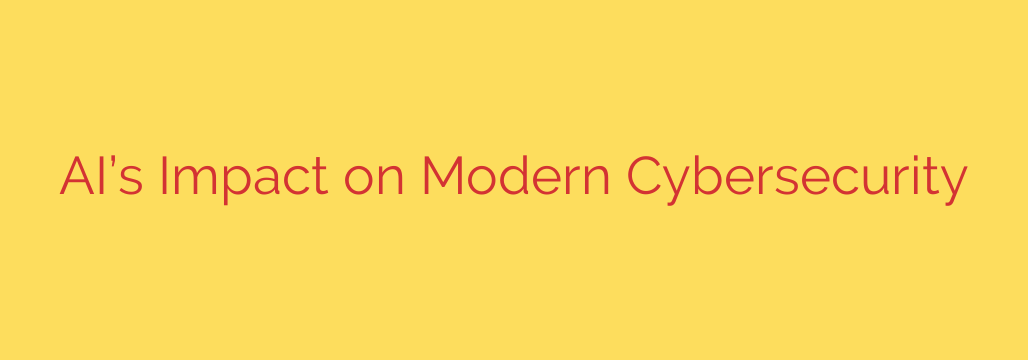
How AI is Reshaping the Cybersecurity Landscape
The world of cybersecurity is in a state of constant evolution, locked in a perpetual arms race between attackers and defenders. Today, a powerful new force has entered the battlefield: Artificial Intelligence. AI is not just another tool; it’s a transformative technology that is fundamentally changing the rules of engagement. Acting as both a formidable shield and a potent weapon, AI is reshaping the entire digital security landscape.
Understanding this dual role is crucial for any organization looking to protect its valuable assets in an increasingly complex threat environment.
AI as a Powerful Shield: Enhancing Digital Defenses
For cybersecurity professionals, AI and machine learning are game-changers, offering capabilities that far exceed human limitations. By processing massive volumes of data in real-time, AI systems can identify threats with unprecedented speed and accuracy.
Here’s how AI is bolstering our defenses:
Proactive Threat Detection and Prevention: Traditional security tools often rely on known threat signatures, leaving them vulnerable to new, unseen attacks. AI-powered systems, however, establish a baseline of normal network activity and can instantly detect anomalies that signal a potential breach. This allows security teams to move from a reactive to a proactive posture, often stopping attacks before they can cause damage.
Automating Security Operations: Security analysts are frequently overwhelmed by a flood of alerts, many of which are false positives. AI automates the tedious process of sorting and prioritizing these alerts, freeing up human experts to focus on complex strategic threats. This automation leads to faster incident response times and a more efficient security workflow.
Advanced Vulnerability Management: Manually scanning millions of lines of code or complex network configurations for weaknesses is a monumental task. AI can analyze systems and applications to identify vulnerabilities much faster and more accurately than human teams, helping organizations patch critical flaws before they can be exploited by attackers.
The Double-Edged Sword: AI-Powered Cyber Threats
Unfortunately, the same technology that empowers defenders is also being weaponized by malicious actors. Cybercriminals are leveraging AI to create more sophisticated, evasive, and scalable attacks that can bypass conventional security measures.
The dark side of AI in cybersecurity includes:
Hyper-Realistic Phishing and Social Engineering: Attackers are using AI to craft highly personalized and convincing spear-phishing emails that are nearly impossible to distinguish from legitimate communications. Furthermore, the rise of deepfake technology allows criminals to clone voices and create fake videos for advanced social engineering schemes, such as impersonating a CEO to authorize fraudulent wire transfers.
Intelligent and Evasive Malware: Modern malware is being designed with AI capabilities. This allows it to adapt to its environment, change its code to avoid detection (polymorphic malware), and learn how to bypass specific security tools on a target’s network. This “smart” malware can remain dormant until the most opportune moment to strike, making it incredibly difficult to find.
Automated Hacking and Attacks: AI can automate the entire attack lifecycle, from reconnaissance to exploitation. Malicious AI bots can continuously scan the internet for vulnerable systems, identify the weakest points, and launch coordinated attacks at a massive scale—far beyond the capabilities of a human hacking team.
Staying Ahead: How to Defend Against AI-Powered Threats
In this new era, fighting AI-driven attacks requires an AI-driven defense. Organizations cannot afford to stand still. Protecting your digital assets requires a modern, forward-thinking approach.
Here are actionable steps to enhance your security posture:
Adopt an AI-Powered Defense Strategy: The most effective way to counter AI-powered threats is with AI-powered security solutions. Invest in tools that use machine learning for threat detection, behavioral analysis, and automated incident response.
Prioritize Continuous Employee Training: Your employees are the first line of defense. Conduct regular training to educate them on the latest threats, especially sophisticated phishing emails and deepfake-based scams. A well-informed workforce is a critical security asset.
Implement a Zero Trust Architecture: The old “trust but verify” model is obsolete. A Zero Trust framework operates on the principle of “never trust, always verify.” This means every user and device must be authenticated and authorized before accessing resources, significantly reducing the potential impact of a breach.
Strengthen Data Security and Encryption: Ensure that your most sensitive data is encrypted both at rest and in transit. Even if attackers breach your perimeter, strong encryption can render the stolen data useless to them.
The integration of artificial intelligence into cybersecurity marks a critical turning point. While it presents some of the most sophisticated challenges we have ever faced, it also offers our most promising solutions. The future of digital security will be defined by how effectively organizations can leverage AI as a defensive ally while preparing for its use as an offensive weapon.
Source: https://www.bleepingcomputer.com/news/security/the-role-of-artificial-intelligence-in-todays-cybersecurity-landscape/








